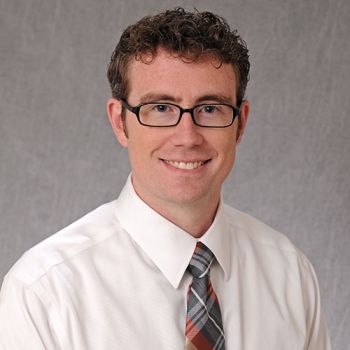
Patients suffering from various diseases can benefit from different forms of exercise, and the George Washington University (GW) School of Medicine and Health Sciences’ (SMHS) Josh Woolstenhulme, Ph.D., D.P.T., is using his degrees in physical therapy and rehabilitation physiology to help figure out the most efficient ways to prescribe exercise.
Woolstenhulme originally imagined a career as a physical therapist (P.T.) treating orthopedic conditions, but during P.T. school found his interests gravitated more toward the synergies of heart, lung, and muscle function as they related to exercise performance and rehabilitation. After graduating, he took a non-traditional route: Instead of becoming an orthopedic physical therapist, he pursued clinical exercise physiology and cardiopulmonary rehabilitation as a fellow at the National Institutes of Health (NIH).
That experience involved training in clinical research, which in turn led him to earn a Ph.D. in rehabilitation science with an emphasis in cardiorespiratory physiology. Now at GW, Woolstenhulme continues to investigate ways to help people with disease or disability improve their physical function and quality of life through exercise interventions. His ultimate goal is to help establish disease-specific rehabilitation guidelines for various illnesses, specifically for rare and underserved disease populations.
Q: Can you tell me a little but more about your work at NIH?
A: When I was a fellow at NIH, I was in the Rehabilitation Medicine Department (RMD) in the Clinical Center. The RMD at NIH has been doing a lot of interesting, pioneering rehabilitative work with several different disease populations and health conditions, one of which was pulmonary arterial hypertension (PAH). Two of my fellowship mentors, Leighton Chan, M.D., M.P.H., and Randall Keyser, Ph.D., M.D., both launched a clinical trial to examine the effects of vigorous aerobic exercise training in the PAH population, and I was fortunate enough to be intimately involved with that line of work. At the time, the official position of most providers was that exercise was detrimental to this population. Our work at NIH helped to demonstrate with greater clarity and precision that aerobic exercise was overwhelmingly beneficial for patients with PAH across many aspects of health and physical function. In addition to the stimulating research environment, my time at NIH also presented an opportunity for specialized clinical practice. At the time, NIH didn’t have a formal pulmonary rehabilitation program to treat and help patients with advanced lung diseases. Given my P.T. background and interest in cardiopulmonary rehabilitation, I was tasked with helping to begin their first pulmonary rehabilitation program.
For years, cardiac rehab has become very mainstream in treating patients with heart problems, but only fairly recently has pulmonary rehabilitation become more popular. Part of the challenge has been that it wasn’t clear if people with various lung diseases could benefit from exercise training. As more research came out, clinicians started developing pulmonary rehabilitation programs specifically catering to patients with advanced lung diseases and pre/post-lung transplant states.
Q: What brought you to GW?
A: When I finished my Ph.D. work, I wanted to find an environment where I could collaborate with a variety of clinicians and health science researchers. I wanted to find a supportive environment where the institution placed value both on my type of rehabilitative care research and in my career development. As I looked at several institutions, I got the impression that GW would do just that. At the same time, the GW P.T. department was looking for a faculty member with a background in rehabilitation physiology and an interest in cardiopulmonary rehabilitation. GW was willing to give me a shot, and now I’m starting my second year here.
Through the generous support of the SMHS leadership, I was able to build a clinical exercise and applied physiology laboratory during my first year here at GW. Now that the second year is starting, we’re putting the finishing touches on the lab, seeking research funding, and spinning up a number of different research projects within the P.T. department and in collaboration with physicians from GW’s Medical Faculty Associates.
Q: How is the view of rehabilitation changing?
A: The rehabilitation field in general is underserved from a research perspective. The medical field has a rich heritage of research relating to pathology, drug discovery, and innovative surgical procedures. However, in terms of rehabilitation, there is still so much to learn about the many complex physiologic responses and adaptations that occur in response to exercise interventions.
In years past, I think some rehabilitation professionals had a tendency to prescribe exercise without much precision. The trend now is to seek to prescribe exercise as you would a drug by individually tailoring exercise interventions to elicit specific responses and adaptations crafted to optimally benefit each person. This is easier said than done, and we have a long way to go before we do it well. We’re still trying to figure out exactly how much exercise and what kinds of exercise are optimal for individuals, and even less is known about specific disease populations.
Q: What do you like most about your work?
A: Working with students and faculty from the P.T. department and across SMHS has been very rewarding. These are amazing people who are dedicating their lives to helping people in need. There’s a special comradery that exists there. While other medical professions do so much to save lives, rehabilitation is special in that it’s intimately involved in daily struggles and in all the little steps needed in helping people put their lives back together as they return to the daily activities that mean so much to them. It’s immensely rewarding to be involved in making that process more effective through research and in helping students grow to become world-class physical therapists.


